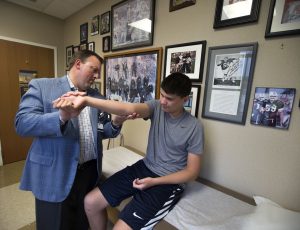The need for Tommy John Surgery, the procedure used to repair a damaged ulnar collateral ligament (UCL) of the elbow, is occurring at an alarming rate among younger and younger athletes. Today’s hyper-competitive youth sports environment, early sport-specialization trends, and the remarkable success of the procedure itself have all contributed to a dangerous desensitization of risk factors.
A HIDDEN DANGER
With every new spring season, the sights, sounds and smells of baseball awaken on ballfields across the country. It’s a time of great joy and excitement for ballplayers who can’t wait to dig in their cleats and slide into second base again.
For most, it’s been 9 months since they last eagerly put on a uniform; but for others, last year’s fall season transitioned straight into winter instructional programs and then again into the new spring season.
For those young athletes who play baseball year-round, a hidden danger is lurking amongst all the enthusiasm, and its name is Tommy John.
TOMMY JOHN
Tommy John was a major league pitcher with the Los Angeles Dodgers and New York Yankees who, in 1974, underwent the first surgery to reconstruct an ulnar collateral ligament (UCL) of the elbow. His had ruptured while on the mound, putting the remainder of his playing career in jeopardy. The experimental surgery was pioneered by Dr. Frank Jobe who with this revolutionary new procedure, forever changed the landscape of baseball and professional sports. Not only did Tommy John return to the major league mound, he went on to win more games post-surgery than he had prior and pitched until he was 46 years old. The operation from which he was the first beneficiary now fittingly carries his name.
TOMMY JOHN SURGERY & THE IMPACT ON YOUNG ATHLETES
We instinctively think of Tommy John Surgery (TJS) belonging to the realm of professional sports and athletes. We often hear of MLB pitchers losing full seasons due to the need for the procedure. The surprising reality is that nearly 60% of all TJ surgeries in the United States are performed on 15–19-year-old kids. Orthopedic surgeons describe the growing volume of cases among this age group as an epidemic requiring the industry’s full and immediate attention.
RISK FACTORS FOR YOUNG ATHLETES
Catastrophic injuries of this nature don’t occur in a vacuum; they’re affected by years of adverse risk factors that weaken the stability of the elbow and ultimately cause the ligament to fail. The onset of this weakening process can begin as early as 6, 7 and 8 years old.
OVERUSE & SPECIALIZATION
Overuse is far and away the leading cause of shoulder and elbow injuries in young athletes, particularly UCL injuries. Youth baseball is now available throughout the calendar year with seasonal leagues, travel teams, showcase tournaments and special instructional programs. It’s also often the case, too, that kids will play on more than one team at a time, experience overlapping schedules and jump from one season directly into the next.
The risk with this type of specialization, particularly for pitchers, is not getting the proper rest their still maturing arms need to fully recover from throwing. Growing bodies need time to rest – more time, in fact, than we may realize – to minimize the risk of serious injury down the road.
FATIGUED ARMS
It’s the accumulation of throwing with fatigued arms that puts young athletes most at risk. Players, parents, coaches, officials and administrators should all coordinate efforts to spot and preempt typical types of fatigue scenarios.
‘Event fatigue’ is one scenario, in other words, throwing too many pitches or innings in a single game without the prerequisite rest ahead of time. Another is ‘seasonal fatigue,’ throwing too much and too frequently over the course of a long season. And ‘annual fatigue,’ where an athlete doesn’t get the recommended 3-4 consecutive months of non-throwing rest prescribed for pitchers at all levels of play. Too much, too fast is a troubling reality for many kids, as studies have shown that young pitchers who throw with tired arms are 36x more likely to experience shoulder and elbow injuries as compared to their well-rested counterparts.
POOR PITCHING MECHANICS
Poor pitching mechanics are another predictive risk factor for UCL problems. Repeatedly throwing a baseball, overhand, at high velocities places stress on the arm even with the purest of deliveries, much more so without the proper use of legs and core to generate force. Any breakdown along the kinetic chain, starting with the feet and ending at the wrist, puts undue, and unnatural, strain on the elbow. Although we often hear about pitchers described as having been blessed with God-given arm talent, the reality is the UC ligament is not designed to withstand that type of constant strain, often leading to its ultimate failure.
THE RISKS ARE WORTH TAKING
Despite the warning signs, many kids and parents alike feel the risks are worth taking. The techniques performed in Tommy John surgeries have advanced greatly over the decades, and given the high percentage of patients who experience positive outcomes, many believe that if indeed it did happen to them, they would come out the other side even better than before.
There is no scientific evidence, however, that a pitcher at any level throws harder as a result of a new elbow ligament. Any gain in velocity is thought to result from strengthening the arm and body during the intense 12–18-month rehabilitation process. Regardless, the fact that so many pitchers have returned to the mound post-TJS has desensitized many to the point where the procedure is now often considered routine.
PITCH & INNING COUNTS
There are a lot of ways a young ballplayer can mitigate the risks of repetitive throwing in an effort to avoid the operating table. For one, pitch and inning counts. Many youth leagues now require mandatory rest time for pitchers based on the amount of throwing done over a certain period of time.
SPORT DIVERSIFICATION
Another is not specializing at all; rather, participating in several different sports throughout the course of a calendar year. Playing multiple sports tends to produce more well-rounded athletes but more importantly, ensures the proper recovery time from stressful, highly-repetitive throwing motions.
PROPER EFFORT EXPENDITURE
More fundamentally, prioritizing proper warm-up routines and encouraging pitchers not to throw with 100% max effort every pitch can go a long way. Judiciously pacing energy and force expenditure while on the mound affords a proportional pacing benefit of stress and wear on the elbow.
REST
Finally, and most importantly…rest. Never allow a young athlete to throw with a fatigued arm. Watch for changes in body language like shaking or rubbing of arms or the sudden loss of velocity and control. Any of these warning signs may signal a potential injury or the need for additional recovery time.
In the end, there’s no way to know for certain if a young pitcher will ever face the prospect of Tommy John surgery. Taking preventative measures at early ages can greatly improve the odds, however, and allow us all to return to the carefree joys of spring and youth baseball.






0 Comments